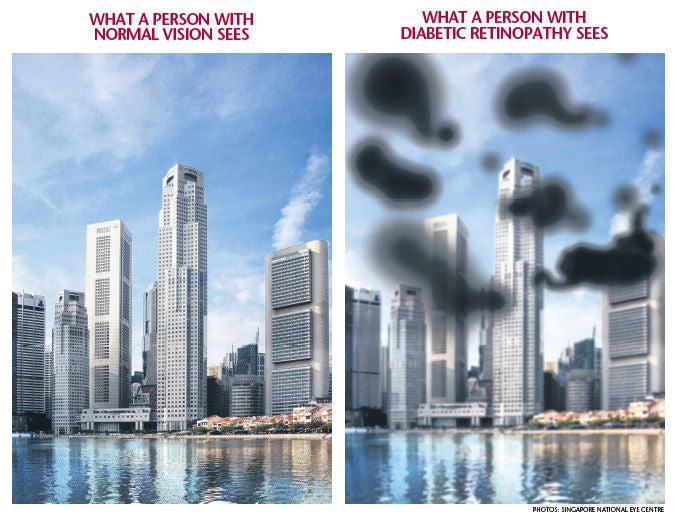
150,000 people in Singapore unaware they have the eye condition: Study
Many diabetic patients in Singapore are at risk of losing their vision, as most of those who suffer from a diabetes-linked eye condition do not even know they have the problem, a large-scale study has found. Five in six people who have diabetic retinopathy (DR), or damage to the blood vessels in the eye, are unaware that they have the condition, said the study published in the British Journal of Ophthalmology this month.
This means that 150,000 people have the condition but are unaware of it. DR is the top cause of blindness among working-age adults in Singapore, causing an estimated 600 people to be totally blind and over 8,000 to lose their sight in one eye.
Another 17,500 are visually impaired because of the condition, said Associate Professor Cheng Ching Yu, who heads the Ocular Epidemiology Research Group at the Singapore Eye Research Institute.
The study, which involved 10,033 people aged 40 to 80 living in the south-western part of Singapore, showed that three in 10 diabetics have the disease. With Singapore having an estimated 600,000 diabetics aged 18 to 69, this means about 180,000 have the eye condition and only 30,000 have been diagnosed.
The high rate of undiagnosed DR cases has surprised Prof Cheng, one of the researchers in the study, as regular eye checks are part of the standard treatment for diabetes. In the study, participants were tested for diabetes and had two retinal photographs taken after their pupils were dilated. The study was done between 2004 and 2011.
It found that 11 per cent of diabetics and 83 per cent of those with DR were undiagnosed. There are no symptoms in the early stages of DR. Nine in 10 of those who did not know they had DR were aware they were diabetic, with most receiving treatment for diabetes.
The study also turned up 212 people who have had the diabetic eye condition for so long that they were at high immediate risk of going blind, and had to be given immediate treatment.
The average age for this group was 62 years. Damage from DR is non-reversible, but treatment can significantly reduce a person’s risk of going blind. According to the United States’ National Eye Institute, treatment can reduce the risk of going blind in the next five years by 95 per cent.
Prof Cheng said a person can be given repeat treatment if the condition worsens.
The study report said: “A timely diagnosis of vision-threatening DR is necessary to institute sight-saving treatments, and an early diagnosis of DR is a key starting point.”
It added that there is well-established treatment, but diabetics in Singapore are going blind because they are not seeking such treatment, largely because they were not even aware of their problem.
Another Singapore National Eye Centre study of more than 500 people done this year and released yesterday found that 42 per cent of diabetics had never had their eyes screened.
Screening for DR costs Singaporeans $10.50 at polyclinics and about $16 at a community health centre. The study also found that the incidence of both DR and the late-stage vision-threatening DR was highest among Indians. Of the 212 people with vision-threatening DR, 102 were Indian, 72 were Malay and 38 were Chinese.
Of those with earlier stages of the condition, 293 were Indian, 193 Malay and 105 Chinese. Prof Cheng said that if the condition is untreated within four years, one in nine would develop vision- threatening DR and one in 14 would become blind.
The researchers claim the study is the first in the world to look at the rates of vision-threatening DR. A previous American study looked only at DR, and not the severe version.
Study on eye diseases: Other key findings
The Singapore Epidemiology of Eye Diseases study was carried out between 2004 and 2011 at a cost of about $5 million funded by the National Medical Research Council and the Biomedical Research Council, Singapore.
The study started with 3,280 Malays, followed by 3,400 Indians and 3,353 Chinese – all living in the south-western part of the country.
It is the source of more than 250 published papers, making it one of the most published cohort studies worldwide.
Among the study’s findings:
- There is a larger loss in the quality of life as a result of poor eyesight, compared with conditions such as obesity, hypertension, diabetes and high cholesterol levels. Poor eyesight affects Malays most, followed by Indians and Chinese.
- Age-related macular degeneration is more common in Chinese and Indians than Malays. The risk is higher as a person ages and is also higher for a heavy smoker or someone with kidney failure.
- The study of the Malay cohort found that 0.3 per cent is blind in both eyes. Of these people, two in three had cataract, a clouding of the eye’s lens. Another 4.4 per cent have low vision in both eyes.
- Indians in Singapore have lower rates of blindness compared with people in India.
Cataract is the leading cause of their going blind, with diabetic retinopathy, or damage to the blood vessels in the retina, causing one in 20 cases of blindness in both eyes. - People with severe diabetic retinopathy were six to 12 times more likely to do less of daily living activities than peers without this eye problem.
Contributed by

English
The Straits Times - SNEC Medical Director and SERI doctors on study for diabetic retinopathy.pdf














 Get it on Google Play
Get it on Google Play